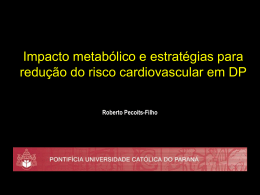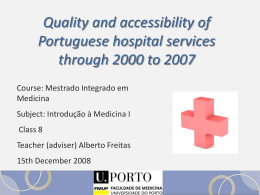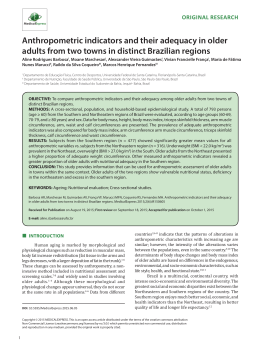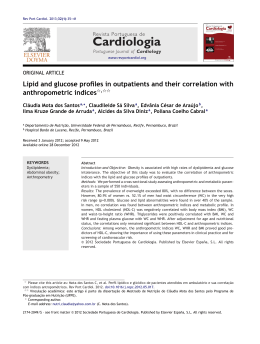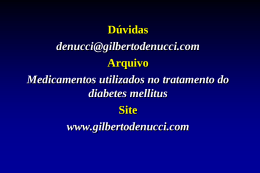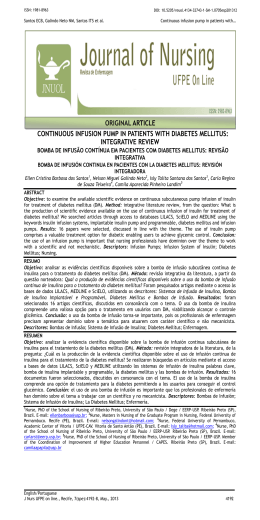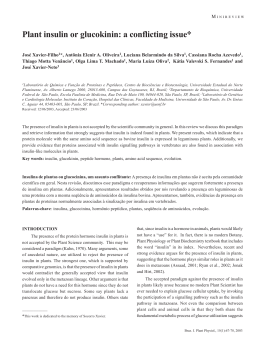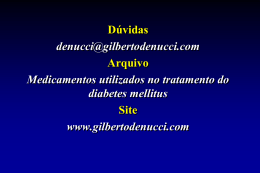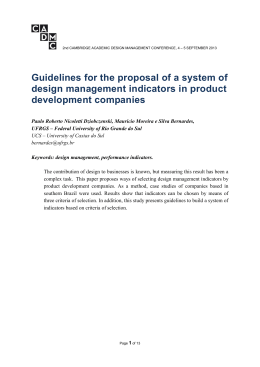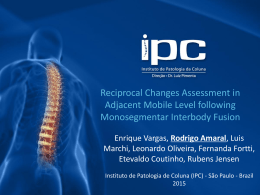Anthropometric indicators in identification of insulin resistance in elderly men Indicadores antropométricos na identificação de resistência à insulina em homens idosos Pamella Cristine Anunciação* Rita de Cássia Lanes Ribeiro** Keywords: Elderly. Anthropometry. Body Composition. HOMA. Resumo A resistência à insulina (RI) aumenta com o avanço da idade, no entanto os mecanismos não estão bem estabelecidos. Os indicadores antropométricos e de composição corporal são instrumentos alternativos para a avaliação da resistência à insulina de maneira rápida, não-invasiva e de baixo custo. O objetivo deste estudo foi avaliar a associação entre os indicadores antropométricos e a resistência à insulina em homens idosos. Estudo transversal com 62 homens com idade entre 60 e 92 anos. Foram avaliados perímetro da cintura (PC), diâmetro abdominal sagital (DAS), índice de massa corporal (IMC), índice sagital (IS), índice de conicidade (ICO), percentual de gordura corporal (%GC) e as relações cintura-quadril (RCQ), cintura-estatura (RCE) e cintura-coxa (RCC). RI foi determinada pelo índice de resistência à insulina (HOMA-IR). Análises estatísticas consistiram de análises de correlação e regressão linear. Todos os indicadores antropométricos avaliados correlacionaram-se com o HOMA-IR, destacando-se o DAS (r = 0,680), o %GC (r = 0,651) e o PC (r = 0,591), que apresentaram as maiores correlações com o índice. Todos os indicadores apresentaram aumento progressivo e diferenças significativas com o aumento do HOMA-IR, sendo que para o PC, DAS e %GC as diferenças entre os quartis do HOMA‑IR foram ainda mais acentuadas. %PC foi preditor significativo para resistência à insulina. Portanto, os indicadores de obesidade correlacionaram com o índice HOMA-IR. Ressalta-se a relação mais forte das medidas de adiposidade central com resistência à insulina, sugerindo a utilidade do diâmetro abdominal sagital na avaliação de idosos. Palavras-chave: Idoso. Antropometria. Composição Corporal. HOMA. DOI: 10.15343/0104-7809.20153902157163 * Department of Nutrition and Health, Universidade Federal de Viçosa, Viçosa-MG, Brasil. E-mail: [email protected] ** Department of Nutrition and Health, Universidade Federal de Viçosa, Viçosa-MG, Brasil. E-mail: [email protected] The authors declare no conflicts of interest. Artigo Original • Original Paper Abstract Insulin resistance (IR) increases with advancing age, yet the underlying mechanism is not well established. Anthropometric and body composition indicators are alternative tools for assessing insulin resistance in a fast, non-invasive and inexpensive way. This study aimed to evaluate the association between anthropometric indicators and insulin resistance in older men. This cross-sectional study included 62 men aged between 60 and 92 years. We evaluated waist circumference (WC), sagittal abdominal diameter (SAD), body mass index (BMI), sagittal index (SI), conicity index (CI), body fat percentage (BF%), waist-to-hip ratio (WHR), waist-to-height ratio (WHtR) and waist-to-thigh ratio (WTR). IR was determined by homeostasis model assessment (HOMA-IR). Statistical analysis consisted of correlation coefficient. All anthropometric indicators correlated with HOMA-IR, highlighting the SAD (r = 0.680), BF% (r = 0.651) and WC (r = 0.591), which showed the highest correlations with the index. All measurements showed significant differences and progressive increase with increasing HOMA-IR. The differences between quartiles of HOMA-IR were even more pronounced for WC, SAD and BF%. BF% was a significant predictor for insulin resistance. Thus, obesity indicators correlated with the HOMA-IR index. We emphasize the stronger relationship between measures of central adiposity and insulin resistance, suggesting the usefulness of SAD in evaluating elderly subjects. O Mundo da Saúde, São Paulo - 2015;39(2):157-163 157 INTRODUCTION Anthropometric indicators in identification of insulin resistance in elderly men O Mundo da Saúde, São Paulo - 2015;39(2):157-163 158 Insulin resistance (IR) is defined as a defect in insulin action with consequent compensatory hyperinsulinemia to maintain normal glucose levels1. Insulin resistance occurs in many tissues including liver, muscle and adipose tissue2. An important contributor to IR is the presence of elevated serum levels of free fatty acids from the increased mobilization of triglycerides from adipose tissue1. Evidences suggest that aging is closely associated with insulin resistance and this is an important risk factor for diabetes, cardiovascular disease and other age-related diseases3,4. Greater age has been associated with an increase in postchallenge plasma glucose levels and postprandial hyperglycaemia, reflecting an underlying agerelated increase in peripheral insulin resistance3. Although the exact molecular mechanisms driving the onset of insulin resistance are not yet fully understood, it is evident that overweight/obesity and aging are the main risk factors for development of type 2 diabetes mellitus4. In this context, the IR evaluation has received considerable attention since the early identification of this metabolic alteration implies the possibility of disease prevention, improved quality of life and lower health costs5. The euglycemic hyperinsulinemic clamp is the gold standard method for determining the IR. However, it is a costly, time consuming, invasive and highly complex technique. An alternative to the evaluation of IR is the homeostatic model assessment index of insulin resistance (HOMA-IR), is a validated method which predicts insulin sensitivity by simple measurements of fasting blood glucose and insulin, is easier to apply and has a strong correlation with the clamp method. HOMA-IR is a suitable method for large-scale studies6. Anthropometric and body composition indicators are alternative instruments to evaluate IR in an accessible, fast and noninvasive manner5. The anthropometric indicators that have been associated with insulin resistance are sagittal abdominal diameter (SAD), waist circumference (WC), body mass index (BMI), body fat percentage (BF%), conicity index (CI), sagittal index (SI) and waist-hip ratio (WHR), waist-to-height ratio (WHtR) and waist-to-thigh ratio (WTR)5,7-11. However, few studies have evaluated the relationship of these indicators with insulin resistance in the elderly. Thus, the present study aimed to evaluate the behavior of anthropometric indicators and body composition in relation to the values of HOMA-IR in elderly men. METHODS This is a cross-sectional study performed in Viçosa, Minas Gerais, Brazil, from July 2011 to February 2012, with the participation of men aged ≥ 60 years enrolled in the Family Health Program, because this comprises the cut-off classification for elderly individuals in Brazil.. The sample size was calculated considering 4.3% as the frequency of MS observed in a previous study12, an acceptable range of variation of 5% and 95% as the alpha risk, resulting in a minimum sample of 62 elderly men. Exclusion criteria were: previous coronary events and use of medications that could interfere with glucose homeostasis, blood pressure and/or lipid metabolism. We conducted home visits to elderly subjects for them to complete a questionnaire containing questions related to health status and lifestyle. The study protocol was approved by the Ethics Committee on Human Research of the Universidade Federal de Viçosa (Viçosa, Brazil) and all participants provided written informed consent. Anthropometry and body composition The anthropometric measurements were performed by a single professional. Body weight and height were measured according to procedures proposed by Jelliffe13 and BMI was calculated as weight divided by height squared (kg/m2). Waist circumference (WC) was measured at the midpoint between the iliac crest and the last rib, and hip circumference (HC) was measured at the level of maximum protrusion of the gluteal muscles. Tight circumference (TC) was measured on the right leg, at the midpoint between the inguinal fold and the proximal border of the patella. The sagittal abdominal diameter (SAD) was Clinical and biochemical measurements Blood pressure was measured on the participant’s left arm using an aneroid sphygmomanometer by a single skilled professional and the procedure was performed according to recommendations of the Brazilian Society of Cardiology. Blood samples were collected after fasting overnight, centrifuged for 10 min at 2250 g and were stored at -80 °C for subsequent assays. Fasting insulin concentrations were analyzed by electrochemiluminescence, using enzymatic kit (Roche®, Brazil). The HOMA-IR (homeostasis model assessment – insulin resistance) was calculated according to the formula proposed by Matthews et al.15. Insulin resistance was defined as HOMA-IR > 2.76. Statistical Analysis Statistical analyzes were performed using SPSS software, version 17.0 9 (SPSS Inc., Chicago, IL, USA). P < 0.05 (two-tailed) was considered statistically significant. The distribution normality of the variables was determined by the Kolmogorov–Smirnov test. Analysis of variance (Anova) was used to compare the quartiles of the HOMA-IR index and the anthropometric indicators, followed by Tukey test. Spearman’s correlations and multiple linear regression were used to evaluate the correlation between anthropometric indicators and HOMA-IR. Age-adjusted correlations were also examined. For variables with a nonnormal distribution, data were transformed to a natural logarithm (Ln). The study sample consisted of 62 men aged between 60 and 92 years (Table 1). According to BMI, 21% were overweight and 54.8% were eutrophic. Table 1. Characteristics of the study sample (n = 62). Viçosa/MG, 2012. Variable Age Values 66 (60 – 92) Weight (kg) 67.32 (10.73) Height (cm) 1.65 (0.06) BMI (kg/m²) 24.79 (3.51) WC (cm) (91.77) (10.35) SAD (cm) 20.17 (2.79) WHR 0.94 (0.07) SI 0.42 (0.06) CI 1.32 (0.07) WHtR 0.56 (0.06) WTR 1.91 (0.19) BF% 22.19 (7.65) Systolic blood pressure (mmHg) 120 (110 – 160) Fasting blood glucose (mg/dL) 81.5 (70 – 160) Triglycerides (mg/dL) HDL-c (mg/dL) HOMA-IR 92.40 (44.69) 47.48 (14.47) 1.09 (0.17 – 9.97) BMI: body mass index; WC: waist circumference; SAD: Sagittal abdominal diameter; WHR: waistto-hip ratio; SI: sagittal index; CI: conicity index; WHtR: waist-to-height ratio; WTR: waist-to-thigh ratio; BF%: body fat percentage; HDL-C: high density lipoprotein cholesterol; HOMA-IR: homeostasis model assessment for insulin resistance. Values expressed as mean or median depending on the variable distribution in the normal curve. All anthropometric indicators increased and differed with the progressive increase in O Mundo da Saúde, São Paulo - 2015;39(2):157-163 159 RESULTS Anthropometric indicators in identification of insulin resistance in elderly men measured at the midpoint between the iliac crests with a portable, sliding beam, abdominal caliper (Holtain Kahn Abdominal Caliper®, Holtain Ltd., Dyfed, Wales, UK). All measurements were taken in duplicate and an average was calculated. If the difference between the two measurements was >1 cm, a third measurement was performed and the two closest values were used. The following relationships between measurements were used: waist-to-hip ratio (WHR) calculated as WC divided by HC; waist-to-height ratio (WHtR) as WC divided by height; conicity index (CI) was calculated according to the formula proposed by Valdez14; sagittal index (SI) as SAD divided by TC; and waist-to-thigh ratio (WTR) was calculated as WC divided by TC. The body fat percentage (BF%) was measured by dual energy x-ray absorptiometry (DEXA) (Lunar Densitometry, GE®, software Encore 2010, version 13.3). HOMA‑IR index (Table 2). For the WC, SAD and BF% the differences between HOMA-IR quartiles were even more pronounced. Table 2. Correlations between anthropometric and body composition indicators and HOMA-IR in the elderly subjects (n = 62). Viçosa/MG, 2012. Anthropometric indicators in identification of insulin resistance in elderly men O Mundo da Saúde, São Paulo - 2015;39(2):157-163 160 to HOMA‑IR. In ROC curve analysis, the WC had the best performance. Table 3. Partial correlations between anthropometric and body composition indicators and HOMA-IR, adjusted for age in the elderly subjects (n = 62). Viçosa/MG, 2012. Variable HOMA-IR Variável HOMA-IR WC (cm) 0.591* WC (cm) 0.565* SAD (cm) 0.680* SAD (cm) 0.623* BMI (kg/m²) 0.543* BMI (kg/m²) 0.502* WHR 0.494* WHR 0.383* SI 0.530* SI 0.525* CI 0.497* CI 0.431* WHtR 0.537* WHtR 0.501* WTR 0.398* WTR 0.520* 0.651* BF% 0.588* BF% WC: waist circumference; SAD: Sagittal abdominal diameter; BMI: body mass index; WHR: waistto-hip ratio; SI: sagittal index; CI: conicity index; WHtR: waist-to-height ratio; WTR: waist-to-thigh ratio; BF%: body fat percentage. *p<0.05. WC: waist circumference; SAD: Sagittal abdominal diameter; BMI: body mass index; WHR: waistto-hip ratio; SI: sagittal index; CI: conicity index; WHtR: waist-to-height ratio; WTR: waist-to-thigh ratio; BF%: body fat percentage. *p<0.05. In general, the anthropometric indicators were correlated with HOMA-IR (p<0.01), highlighting SAD and BF%, which were strongly correlated, followed by WC (Table 3). The WTR showed the lowest correlation with HOMA-IR. After adjusting for age, all indicators were correlated with HOMA-IR, mainly the SAD (Table 4). After testing all the variables that showed significant correlations, the results show that the body fat percentage significantly predicted 41% of the variation in HOMA-IR index (Table 5). Anthropometric and body composition indicators showed significant differences with the progressive increase in HOMA-IR index, especially the WC, SAD and BF%, in which the differences between HOMA-IR quartiles were even more pronounced. Another study also observed a progressive increase for all indicators with increased HOMA-IR, and for BMI and for central obesity indicators the differences between the quartiles were even more pronounced5. Correlations between anthropometric indicators and HOMA-IR were consistent with expectations, since it is known that adiposity deteriorates insulin sensitivity17. Waist circumference positively correlated with HOMA-IR index, even when adjusting for age (r = 0.591, r = 0.565, respectively). In adult men the WC was significantly correlated with HOMA-IR (r = 0.464)5. Other studies involving older adults verified that the WC positively correlated with HOMA‑IR10,11,18. These findings indicate that not only the amount of adipose tissue, but its distribution, may influence insulin resistance and metabolic alterations caused by hyperinsulinemia. DISCUSSION The indicators of central obesity, SAD and WC, and the BF% showed the best correlation with the HOMA-IR index, while all other indicators have shown moderate correlations. Another study observed better efficacy for SAD and WC, respectively, to identify insulin resistance in men as compared to BMI and WHR16. Vasques et al.5 evaluated 138 adult men and observed that central obesity indicators in particular SAD and WC, showed better correlations Table 4. Distribution of anthropometric indicators according to the quartiles of HOMA index (n = 62). Viçosa/MG, 2012. HOMA-IR 1.09-1.76 ≥1.77 WC (cm)* 83.62 (6.34)a 88.81 (9.24)abc 94.33 (7.04)bc 96.82 (12.26)c SAD (cm)** 18.13 (1.64)a 19.30 (1.90)ab 20.95 (1.64)bc 22.02 (3.29)c BMI (kg/m²)* 22.55 (2.56)a 23.53 (2.88)ab 25.50 (2.07)ab 26.09 (4.46)b WHR* 0.89 (0.05) 0.92 (0.05) ab 0.96 (0.06) 0.96 (0.08)b SI** 0.38 (0.04)a 0.40 (0.04)a 0.43 (0.05)ab 0.46 (0.06)b CI* 1.27 (0.05)a 1.30 (0.07)ab 1.33 (0.06)ab 1.35 (0.07)b WHtR* 0.51 (0.05)a 0.53 (0.05)ab 0.57 (0.04)ab 0.58 (0.08)b WTR* 1.76 (0.12) 1.86 (0.18) 1.92 (0.14) 1.99 (0.18)b BF%** 15.52 (6.26)a 25.78 (4.85)bc 26.34 (6.86)c a a ab a 19.72 (5.95)ab ab Data presented as mean (sd). ANOVA followed by Tukey test: * p <0.01; ** p <0.001. Pairs of means followed by different letters differ statistically and when followed by at least one same letter are not statistically different at p <0.05. Table 5. Multiple linear regression coefficient and associated p-value of anthropometric variables and HOMA-IR index in elderly men. Viçosa/MG, 2012. Variables Independent Variable coefficients (β) p value R-squared Body Fat percentage 0.073 <0.001 0.414 Waist-to-hip ratio -1.343 0.470 This model was adjusted for age. The body fat percentage, which provides estimates of generalized fat, correlated significantly with HOMA-IR (r = 0.651) and was a significant predictor of insulin resistance. Wannamethee et al.7 observed that BF% assessed by bioelectrical impedance also correlated with HOMA-IR in elderly men (r = 0.32, p <0.05). However, the WC was a better predictor of metabolic abnormalities than BF%. Although the BF% is an excellent measure of adiposity and energy reserves, it may not reflect risks to health when compared to other anthropometric indicators19. The SAD strongly correlated with HOMA‑IR index, even after adjustment for age (r = 0.680, r = 0.623, respectively). Others studies also showed that SAD positively correlated with HOMA‑IR in adult men5 and in overweight subjects10. The WC and SAD are measures that directly assess the extent of abdominal obesity and exhibit strong correlation with the amount of visceral fat20, which is directly related to metabolic disorders, such as insulin resistance. One of the advantages of SAD is that such measurement is made while the subject is lying down, which avoids that subcutaneous fat overlaps the abdominal fat, reflecting the amount of visceral adipose tissue (Pimentel et al., 2010). It is worth mentioning the technical advantages of the WC and SAD measurements, as the quick execution and the non-use of formulas. The SAD has the disadvantage of requiring an abdominal caliper and a solid surface table for their measurement, unlike the WC, which only requires proper tape. CONCLUSION In general, the anthropometric indicators correlated with HOMA-IR index. The sagittal abdominal diameter, waist circumference and 161 O Mundo da Saúde, São Paulo - 2015;39(2):157-163 0.80-1.08 Anthropometric indicators in identification of insulin resistance in elderly men ≤0.70 body fat percentage were the anthropometric indicators that best correlated with HOMA-IR index in older men. The body fat percentage was a significant predictor of insulin resistance. We emphasize the strongest relationship of central adiposity measures with insulin re- Anthropometric indicators in identification of insulin resistance in elderly men O Mundo da Saúde, São Paulo - 2015;39(2):157-163 162 sistance, suggesting the usefulness of SAD in evaluating elderly subjects. It is suggested that longitudinal studies be conducted in search of best cutoff points for anthropometric indicators identifying the risk of insulin resistance in the elderly population. REFERENCES 1. Rodrigues TC, Canani LH, Gross JL. Síndrome metabólica, resistência à ação da insulina e doença cardiovascular no diabete melito tipo 1. Arquivos Brasileiros de Cardiologia. 2010;94:134-9. 2. Lee BC, Lee J. Cellular and molecular players in adipose tissue inflammation in the development of obesity-induced insulin resistance. Biochimica et biophysica acta. 2013;1842(3):446-62. 3. Dubowitz, N., Xue, W., Long, Q., Ownby, J. G., Olson, D. E., Barb, D., ... & Phillips, L. S. Aging is associated with increased HbA1c levels, independently of glucose levels and insulin resistance, and also with decreased HbA1c diagnostic specificity. Diabetic Medicine. 2014; 31(8), 927-935.4. Steculorum SM, Solas M, Brüning JC. The paradox of neuronal insulin action and resistance in the development of agingassociated diseases. Alzheimer’s & Dementia, 2014; 10(1), S3-S11. 5. Vasques ACJ, Rosado LEFPdL, Rosado GP, Ribeiro RdCL, Franceschini SdCC, Geloneze B, et al. Habilidade de indicadores antropométricos e de composição corporal em identificar a resistência à insulina. Arquivos Brasileiros de Endocrinologia & Metabologia. 2009;53:72-9. 6. Geloneze B, Vasques AC, Stabe CF, Pareja JC, Rosado LE, Queiroz EC, et al. HOMA1-IR and HOMA2-IR indexes in identifying insulin resistance and metabolic syndrome: Brazilian Metabolic Syndrome Study (BRAMS). Arquivos brasileiros de endocrinologia e metabologia. 2009;53(2):281-7. 7. Wannamethee SG, Shaper AG, Morris RW, Whincup PH. Measures of adiposity in the identification of metabolic abnormalities in elderly men. The American Journal of Clinical Nutrition. 2005;81(6):1313-21. 8. Chuang Y-C, Hsu K-H, Hwang C-J, Hu P-M, Lin T-M, Chiou W-K. Waist-to-Thigh Ratio Can also be a Better Indicator Associated with Type 2 Diabetes Than Traditional Anthropometrical Measurements in Taiwan Population. Annals of Epidemiology. 2006;16(5):321-31. 9. Chen G, Liu C, Chen F, Yao J, Jiang Q, Chen N, et al. Body fat distribution and their associations with cardiovascular risk, insulin resistance and b-cell function: are there differences between men and women? International Journal of Clinical Practice. 2011;65(5):592-601. 10. Pimentel GD, Moreto F, Takahashi MM, Portero-McLellan KC, Burini RC. Sagital abdominal diameter, but not waist circumference is strongly associated with glycemia, triacilglycerols and HDL-C levels in overweight adults. Nutrición Hospitalaria. 2011;26(5):1125-9. 11. Lim S, Kim JH, Yoon JW, Kang SM, Choi SH, Park YJ, et al. Optimal cut points of waist circumference (WC) and visceral fat area (VFA) predicting for metabolic syndrome (MetS) in elderly population in the Korean Longitudinal Study on Health and Aging (KLoSHA). Archives of Gerontology and Geriatrics. 2012;54(2):e29-e34. 12. Anunciação PC, Ribeiro RCL, Pereira MQ, Comunian M. Different measurements of waist circumference and sagittal abdominal diameter and their relationship with cardiometabolic risk factors in elderly men. Journal of Human Nutrition and Dietetics. 2014; 27(2):162-167. 13. Jelliffe DB. Evaluación del estado nutrición de la comunidad. In: Organización Mundial de La Salud, editor. Ginebra. 1968. 14. Valdez R, Seidell JC, Ahn YI, Weiss KM. A new index of abdominal adiposity as an indicator of risk for cardiovascular disease. A cross-population study. International journal of obesity and related metabolic disorders : journal of the International Association for the Study of Obesity. 1993;17(2):77-82. 15. Matthews DR, Hosker JP, Rudenski AS, Naylor BA, Treacher DF, Turner RC. Homeostasis model assessment: insulin resistance and beta-cell function from fasting plasma glucose and insulin concentrations in man. Diabetologia. 1985;28(7):412-9. 16. Riserus U, Arnlov J, Brismar K, Zethelius B, Berglund L, Vessby B. Sagittal abdominal diameter is a strong anthropometric marker of insulin resistance and hyperproinsulinemia in obese men. Diabetes care. 2004;27(8):2041-6. 17. Rocha NPd, Siqueira-Catania A, Barros CR, Pires MM, Folchetti LD, Ferreira SRG. Análise de diferentes medidas antropométricas na identificação de síndrome metabólica, com ou sem alteração do metabolismo glicídico. Arquivos Brasileiros de Endocrinologia & Metabologia. 2010;54:636-43. 18. Silva JLTd, Barbosa DS, Oliveira JAd, Guedes DP. Distribuição centrípeta da gordura corporal, sobrepeso e aptidão cardiorrespiratória: associação com sensibilidade insulínica e alterações metabólicas. Arquivos Brasileiros de Endocrinologia & Metabologia. 2006;50:1034-40. 19. Shen W, Punyanitya M, Chen J, Gallagher D, Albu J, Pi-Sunyer X, et al. Waist circumference correlates with metabolic syndrome indicators better than percentage fat. Obesity (Silver Spring, Md). 2006;14(4):727-36. 20. Kahn HS, Simoes EJ, Koponen M, Hanzlick R. The Abdominal Diameter Index and Sudden Coronary Death in Men. The American Journal of Cardiology. 1996;78(8):961-4. Recebido em: 02 de fevereiro de 2015. Aprovado em: 20 de agosto de 2015. O Mundo da Saúde, São Paulo - 2015;39(2):157-163 Anthropometric indicators in identification of insulin resistance in elderly men 163
Download



